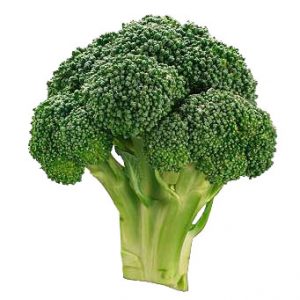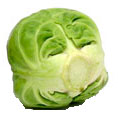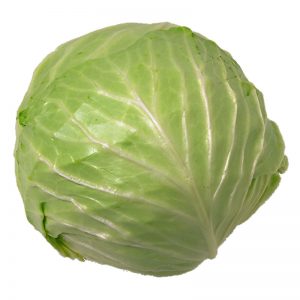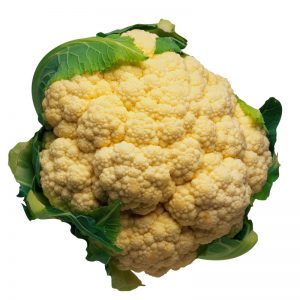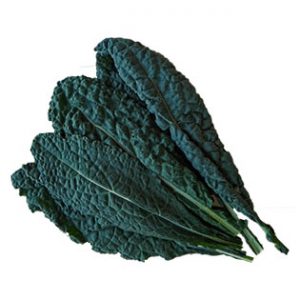Grow your own food
Seed raising
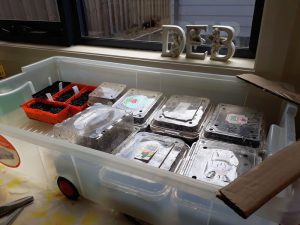 Plastic tubs can make excellent mini hot houses for seed raising. Prop one end open for ventilation. Works well if you're short on space.
Plastic tubs can make excellent mini hot houses for seed raising. Prop one end open for ventilation. Works well if you're short on space.
Planting in seed trays
If planting in seed trays, use a seed raising mix if you can, otherwise potting mix, but not garden soil which compacts around seeds. Fill the trays 3/4 full, firm down the soil, water, sprinkle the seed on the damp firm bed, cover with soil (2-3 times the diameter of the seeds) and water again. Keep the soil damp to prevent small seeds drying out. Use a fine spray from a spray bottle, watering can or hose (heavy watering can wash seeds out). If using old seed trays, scrub out, rinse, then soak for 1 hour in 90% water 10% vinegar (any kind) to kill pathogens in the old soil.
Seedling watering
When watering your punnets of spring seedlings that you have placed in a greenhouse or on a windowsill, use tepid water not cold water straight from the tap. This will provide consistency of temperature and avoid 'shock' to the seedlings.
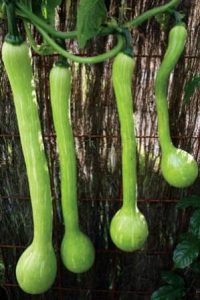 Tromboncino
Tromboncino
When planning what veggies to plant this Spring, consider tromboncino. In terms of both texture and taste, it is roughly halfway between a pumpkin and a zucchini. In terms of growth pattern, it is a vine (like standard pumpkins) but can be grown up vertical structures (unlike standard pumpkins). And its massively long and unusual fruit are both interesting and a talking point.
Growing blueberries
The main species of blueberry is called 'highbush', of which there are two types: 'northern' (which is deciduous) and 'southern' (evergreen). Traditionally, it has been the deciduous northern type that has been planted in Melbourne but Bruce Plain, owner of Bulleen Art & Garden nursery and Eltham resident, tells me (Guy) that, with climate change, the evergreen southern type is becoming increasingly popular. I have roughly equal success (or, more precisely, lack of success!) with both types. If you want to grow the deciduous northern type, Winter is the time to buy it from your local nursery. If, however, you want to grow the evergreen southern type, wait until Spring. All the varieties seem similar to me in terms of both growing habit and taste.
Blueberries are not grown in normal soil! Rather, they require a pH of 4.5-5.5, which is very acidic. To make the soil this acidic, you add some granulated sulphur and dig it through the according to the instructions on the packet. To keep the soil acidic, mulch with pine needles. There are a number of pine trees along the Yarra, for example at Lenister Farm – simply take some big bags and scoop the needles off the ground. Keep the mulch away from the stem to prevent collar rot.
Valencia oranges
Winter is the season when many citrus trees bear fruit. But there is one type of citrus which fruits in summer, namely the valencia orange. So, for example, if you have both a navel orange and a valencia orange, then you will have oranges in both winter and summer.
Stone fruit
Almonds, apricots, cherries, nectarines, peaches and plums are all very closely related (genus Prunus) and are collectively known as stone fruit. They can all be planted now as bare-rooted trees. If you have never grown any stone fruit before, the suggestion is that you start with a plum tree because they have fewer problems than the others: almonds – sometimes doesn't come out of dormancy; apricots – brown rot and gummosis; cherries – pear and cherry slug; and nectarines and peaches – leaf curl.
If you have a nectarine or peach tree (nectarines are just varieties of peach where the skin is smooth), then now is the time to keep your eye on them as you will soon need to spray with a copper fungicide if you want to prevent leaf curl. As Agriculture Victoria says, "Most effective control is achieved by spraying when the buds are swelling but before they have opened." If you need help identifying bud swelling (as opposed to just buds), have a look at this video from Mt Alexander Fruit Gardens. Here is what Gardening Australia says on the subject.
How to prune raspberries and blackberries
There are two types of raspberry:
- 'Summer bearing', which fruit once a year, on 2nd year canes in summer.
- 'Everbearing' (aka 'Autumn bearing'), which fruit twice a year, on 2nd year canes in summer, and on 1st year canes in autumn.
The two types should be pruned differently. If you haven't yet worked out which type you have, prune them as though they are 'summer bearers'. Also, prune both blackberries and blackberry/raspberry crosses (loganberries, marionberries, silvanberries, tayberries, etc) in the same way as 'summer bearers'.
For the 'summer bearers': cut all the canes that have fruited down to the ground (because they won't fruit again). If you don't know which canes have fruited, they are the longer and thicker ones, and they often have multiple lateral branches. Thin the others to 5-7 per plant, shorten them as desired, and tie the ends to your trellis.
For the 'everbearers': you can prune them like the 'summer bearers', in which case you will get two crops (in summer and autumn), neither of which will be prolific. Alternatively, you can sacrifice next summer's crop for a better autumn crop by simply cutting all the canes down to the ground. The second approach is the best approach if you want raspberries in the autumn and it is also the quickest.
See the Wikihow raspberry pruning page.
Seed germination
Here are a few thoughts that you might find helpful.
Traditionally, people divide vegetable seeds between those that you should plant directly where they will grow ('sow direct') and those which you should initially plant in seed trays, with subsequent transplantation after they become seedlings. Direct sowing is traditionally preferred for both big seeds (e.g. beans, pumpkin), on the positive grounds that they will germinate anyway, and for root crops (e.g. beetroot, carrot), on the negative grounds that they resent transplantation. The Local Food Connect planting guide lists the traditional planting method for each vegetable. My experience, however, is that I get better germination for just about all seeds if I plant them in seed trays in my greenhouse because I can control the environment better.
Some seeds germinate better if they have been pre-soaked overnight beforehand. My list here is beetroot, broad beans, capsicum, celery, chilli, okra, parsley, silverbeet and spinach. I think that it is for different reasons for different seeds and I just follow the rules.
Different seeds can be very different sizes but the same rule of thumb for planting depth applies to them all: 2-3 times the seed diameter.
Seed germination does not require fertiliser or other sources of NPK. Rather, initial germination requires water (to activate the relevant biochemical processes), oxygen (to break down the seed's food store) and a physically friable medium (to grow through). So, I water my seeds every day (gently) and I plant them in a very light mixture of coir and sieved compost. Once the plant has germinated, its initial, main requirements are light, carbon dioxide and water, so that the first (cotyledon) leaves can photosynthesise.
Moon phase planting
Lots of people (including, by anecdote, many farmers) practice something called moon-phase planting. There are three very different reasons why you might want to consider moon-phase planting, whereby different types of veggie are planted at different times in the moon’s 29½-day lunar cycle. The first possible reason is that you believe in it. The second possible reason is because it helps to impose discipline on your veggie growing activities. The third possible reason is to help give your life cadence.
To believe in it, you have to understand it a bit. The basic idea/assumption/rationale/sophistry is that one wants root crops to grow downwards, and thus when the upward pull of the moon is lessening, and thus when the moon is waning. By contrast, one wants leafy and fruity crops to grow upwards, and thus when the upward pull of the moon is increasing, and thus when the moon is waxing. This gives the following phasing:
1st quarter: leafy – plant crops where one eats the leaves/foliage.
2nd quarter: fruits – plant crops where one eats the fruit.
3rd quarter: roots – plant root crops.
4th quarter: have a rest!
To do it for discipline reasons, you have to understand one of its major implications. Consider capsicum seeds, which are best planted in August or September. There will be usually be precisely one week in August, and another in September, where the moon is in its 2nd quarter. So, you only have two opportunities in the whole year to plant capsicum seeds and if you miss both these opportunities then you won't have any capsicum plants. So, if you want homegrown capsicums, then you have to be organised and disciplined to get your act together in these two weeks.
Finally, the cadence reason is probably only of potential relevance if you are not in paid work. Those of us who are retired know that days and weeks can flow into each other, with time passing and little rhythm to one's life. Anything that makes one day different than another, or one week different than another, is welcome.
Crop rotation
If you ever grow veggies, they are likely to include tomatoes and you will probably grow tomatoes every year. But you shouldn't grow them in the same place every year. Ditto any other vegetable. This is for two main reasons. First, most pests and diseases prefer specific types of plant; if you change the types of plants that you grow in a specific place from year to year then it helps to break the pest or disease's lifecycle so you will have less pests and fewer diseases. Second, each type of plant places particular demands on the soil in terms of nutrient extraction, etc; if you change the types of plants that you grow in a specific place from year to year then it gives your soil a rest from the particular burdens placed on it.
What is true for specific species of vegetable is also true for groups of vegetables. So, for example and as discussed below under ‘vegetable families’, tomato, capsicum, chilli, eggplant and potato are all in the same family (solanums), all attract the same pest & diseases, and all place similar demands on the soil.
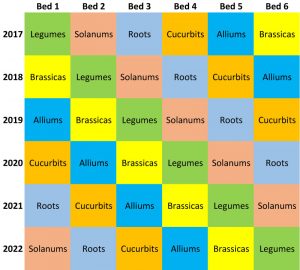 The discussion below under ‘vegetable families’ talks about 5 groups of closely related vegetables plus a miscellaneous list. Divide the miscellaneous list into 'roots' and 'leafy greens' and you get 7 groups in total: alliums, legumes, brassicas, cucurbits, roots, solanums and leafy greens. The 'leafy greens' group is not relevant to crop rotation – just plant them wherever and whenever you have gaps. So, the ideal is a 6-bed, 6-year rotation for the other 6 groups.
The discussion below under ‘vegetable families’ talks about 5 groups of closely related vegetables plus a miscellaneous list. Divide the miscellaneous list into 'roots' and 'leafy greens' and you get 7 groups in total: alliums, legumes, brassicas, cucurbits, roots, solanums and leafy greens. The 'leafy greens' group is not relevant to crop rotation – just plant them wherever and whenever you have gaps. So, the ideal is a 6-bed, 6-year rotation for the other 6 groups.
If you have fewer than 6 beds, then you can either combine some of the groups (e.g. alliums and roots) or omit some of the groups (e.g. brassicas).
You then have to decide the order of how a bed should change over time. A principle here is that heavy feeders should, where possible, alternate with light feeders. So, for example, legumes (light) – brassicas (medium) – alliums (light) – cucurbits (heavy) – roots (light) – solanums (heavy).
And, finally, you have to decide when during the year to rotate the crops, with the obvious time being after the summer harvest.
See the Local Food Connect website for a slightly longer discussion, including which vegetables are in which groups.
Vegetable families
Why is it important to know which vegetables are closely related?
First, it helps you work out how to grow them. For example, if you know how to grow pumpkins, and if you know that cucumbers are closely related to pumpkins, then you can guess that cucumbers are prostrate vines, are grown in summer, are heavy feeders and benefit from hand pollination. Of if you know that broccoli is closely related to cabbage, then you can guess that the cabbage moth likes to lay its eggs on broccoli plants and that you need to protect them from this.
Second, if you are following some system of crop rotation (and you should!), it helps you decide where to plant them.
Many vegetables are in the following 5 groups, where a genus (plural: genera) is a group of very closely related plants and a family is a group of reasonably closely related plants:
- Alliums (a genus): chives, garlic, leek and onion.
- Brassicas (a genus): broccoli, brussels sprout, cabbage, cauliflower, kale, mizuna, mustard greens, pak choy and turnip.
- Cucurbits (a family): cucumber, gourd, pumpkin, rockmelon, watermelon and zucchini.
- Legumes (a family): bean, broad bean, chickpea, peanut and pea.
- Solanums (a family): capsicum. chilli, eggplant, potato, tomato.
The following vegetables are in other families: basil, beetroot, carrot, celery, coriander, fennel, jerusalem artichoke, lettuce, okra, parsley, parsnip, radish, rocket, silverbeet, spinach, sweet potato and sweetcorn.
Here are some characteristics of the 5 groups:
| Group | Growing season | Feeding requirement | What you eat |
| Alliums | varies | light | varies |
| Brassicas | cool season | heavy | varies |
| Cucurbits | warm season | heavy | fruit |
| Legumes | varies | light | fruit |
| Solanums | warm season | heavy | fruit |
Saved seeds – part 2: the practicalities
Although, as per last week's article, the seeds of a named variety of vegetable will be largely genetically uniform, there will still be minor variations. Choose the best fruit (and thus the best seeds) for your seed saving, rather than eating the best and planting the dross. Incidentally, Richard Dawkins said (in The Ancestor's Tale) that his father found this one of the hardest lessons to get across to farmers in Africa in the 1940s.
As also discussed last week, beans and tomatoes are both good plants for seed saving but they are collected rather differently. Tomato seeds grow in moist flesh and require wet cleaning: pick the fruit when it is just over ripe, scoop the seeds out of the flesh, run water over them to remove any flesh remnants, do something (see next sentence) to remove the gel sac around each seed, and then leave to dry for around 10 days before storing. To remove the gel sacs, which can inhibit germination, either wash and physically rub or leave to ferment in water (or their own juices) for around 4 days (Google for more detail). Bean seeds grow in dry receptacles and require dry cleaning: leave on the plant until they are completely dry and then harvest and store. In both cases, store them in dry and dark conditions.
If you want to know more about seed saving, a good book is The Seed Savers' Handbook. Or, if you want a free booklet: A Guide to Seed Saving, Seed Stewardship & Seed Sovereignty.
Saved seeds – part 1: the genetics
First, some genetics 101. Most living organisms are diploid, which means that they have two copies of most of their genes. These two copies can be the same or different. During sexual reproduction, one of these copies will be chosen at random from each of the mother and the father. The child will therefore inherit half of its genes from each of its mother and its father but which genes it inherits is a random process and will differ from child to child. If you think about it, this means that you will have lots of genes in common with your siblings but you will also have some genes which are different. This is why you bear some resemblance to your siblings but are not identical to them.
Most people who grow from saved seed want their vegetable plants to be the same variety as the mother plant from which they saved the seeds. This is called growing true to type. It is equivalent to wanting the seeds to be genetic clones of the mother plant. But fertile seeds are the product of male pollen fertilising female seeds and, as such, the genes of a fertile seed are a random half from the genes of each of the male and the female. For this random combination to have the same genetic composition as the mother plant, two things have to be true. First, the male and female parents have to have identical genes (at least for all the genes that make a material difference). Let's call this condition 1. Second, and perhaps less obviously, for every single gene that matters in both the male parent and the female parent, the two copies have to be identical (this is called homozygosity). Let's call this condition 2. Named varieties of vegetables are effectively those for which condition 2 is true.
Plants can be either self-pollinators (flowers usually pollinate themselves) or cross-pollinators (one flower has to be pollinated by another flower). For self-pollinators, condition 2 being true implies that condition 1 is also true and thus named varieties will grow true to type and their seeds can be saved. Examples are beans, peas and tomatoes. For cross-pollinators, however, condition 1 will only guaranteed to be true if there is only one variety of the plant being grown in the geographic area. Broad beans, capsicums, chillies, eggplants and pumpkins are all cross-pollinators and thus their seed saving is somewhat problematic.
Perhaps most dramatically, cabbage is a cross-pollinator and cauliflower and broccoli are just types of cabbage. So, if you save seeds from your cauliflower, they might well grow into something akin to broccoli (or vice versa). And I know that this can happen because it has happened to me in the past!
Heavy stuff! Here's a web page that covers similar ground using different words.
 Capsicums, chillies and eggplants
Capsicums, chillies and eggplants
Different veggies have different lifecycles. Many are annuals, which means that their entire lifecycle, from birth to death, takes less than a year. Examples are beans, pumpkins and tomatoes. Others are biennials, which means that their lifecycle, whilst predictable, takes two years. Examples are beetroot, onions and parsley. For some biennials, we effectively grow them as annuals because we eat the things that they produce in the first year (e.g. onions). Yet others are perennials, which means that their lifespan is more than a year but unpredictable.  Some perennials typically live for many years (e.g. asparagus and rhubarb), whilst others we effectively grown as annuals (e.g. potatoes).
Some perennials typically live for many years (e.g. asparagus and rhubarb), whilst others we effectively grown as annuals (e.g. potatoes).
That brings me, at last, to capsicums, chillies and eggplants. These are perennial but short-lived, typically living for around three years. But, and here's the main point of this little article, they are frost tender and are typically killed off by the Melbourne Winter. 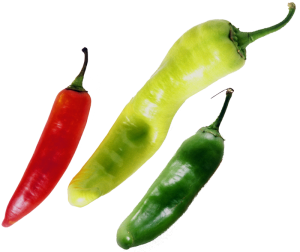 So, if you want to get full value from your capsicum, chilli and eggplant plants, you need to grow them in pots and put those pots in a warm place (e.g. a greenhouse) during Winter. If you have some and they are outside, now (May) is the time to move them to a warmer place.
So, if you want to get full value from your capsicum, chilli and eggplant plants, you need to grow them in pots and put those pots in a warm place (e.g. a greenhouse) during Winter. If you have some and they are outside, now (May) is the time to move them to a warmer place.
Grow your own food in pots
Here is a list of veggies that grow well in pots: garlic, leeks, lettuce, pak choy, radish, rocket, silverbeet, spinach and strawberry.
To ease your watering tasks, use pots with water wells.
Use high quality potting mix but also add some fertiliser (or buy a mix which includes fertiliser) as most veggies are heavy feeders. Then add a liquid fertiliser periodically.
Leeks
 In horticulture, blanching is a technique used in vegetable growing whereby light is purposively excluded from part of the plant, usually to make it paler in colour and/or less bitter in flavour. If you look at a mature leek, the bottom bit will be white and the top bit will be green. The white bit is that which was grown underground. If, like me, you prefer white leek to green leek, then you want as much of the leek as possible to have been grown under ground. This can be achieved through a combination of two techniques: planting the seedlings deeply (say, up to 5-10cm) and hilling up the soil around the plant as it grows (say, up to another 5-10cm). Watch this video by Lower Plenty leek growing expert Bruno Tigani. He plants his leek seedlings in deep holes and then, with rain and wind, the soil collapses in gradually.
In horticulture, blanching is a technique used in vegetable growing whereby light is purposively excluded from part of the plant, usually to make it paler in colour and/or less bitter in flavour. If you look at a mature leek, the bottom bit will be white and the top bit will be green. The white bit is that which was grown underground. If, like me, you prefer white leek to green leek, then you want as much of the leek as possible to have been grown under ground. This can be achieved through a combination of two techniques: planting the seedlings deeply (say, up to 5-10cm) and hilling up the soil around the plant as it grows (say, up to another 5-10cm). Watch this video by Lower Plenty leek growing expert Bruno Tigani. He plants his leek seedlings in deep holes and then, with rain and wind, the soil collapses in gradually.
Similar opportunities apply to celery where, for example, white, non-bitter celery can be obtained by wrapping the bottom half off the plant in paper.
If you have any doubt about the impact that an absence of light can have on a plant, compare witloof with other forms of chicory.
Brassicas
Did you know that broccoli, brussels sprouts, cabbage, cauliflower and kale are all varieties of the same plant (Brassica oleracea)? Together with other closely related veggies, such as pak choy and mustard greens, they are collectively known as brassicas.
Brassicas are more difficult to grow than most other veggies, partly because they attract pests. And their biggest pest is the cabbage moth, which lays its eggs on the plants during Autumn, with the caterpillars then eating large volumes of the plant's leaves.
So, you want to stop the moths laying their eggs on your brassicas. This can be achieved with fine bird netting. You don't want the netting to rest on the plants, because the moths can then lay their eggs through it, so use some sort of wooden or plastic structure upon which to rest the netting. And make sure that the netting goes all the way down to the ground so that the moths can't get underneath it.
If, for some reason, you don't want to use netting, there is another possibility. Cabbage moths are territorial and if they see another cabbage moth in the vicinity, they tend to leave. So, make, or buy, some decoys – just white butterfly shapes on sticks. Many nurseries sell them.
Click here for a more indepth guide to growing brassicas. Click here for an indepth guide to growing cauliflower.
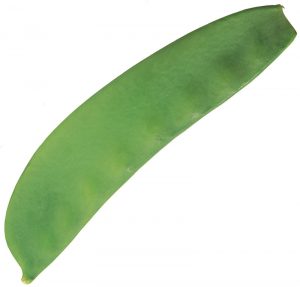 Peas
Peas
Peas are one of those veggies which, like sweetcorn, really do taste better when homegrown rather than store-bought. You grow them just like the broad beans discussed last week. The main difference is that most peas are climbing varieties and they need a climbing frame (although you can get bush varieties). The climbing varieties divide into three broad groups: garden/english (your standard pea with non-edible pods); snow (flat, edible pods; used in Chinese cuisine); and snap (pods edible when young). Snap peas are effectively halfway between garden and snow peas and are the ones that I usually grow, eating them like snow peas when young and like garden peas when older.
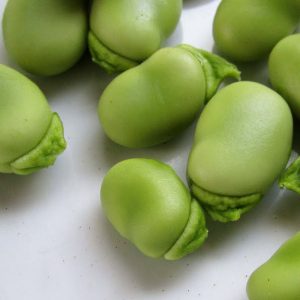 Broad beans (April)
Broad beans (April)
Broad beans are yum, they are easy to grow and the best time to plant them is now or in May.
Broad beans are a type of legume, like peas, beans, chickpeas, peanuts and soya (all of which can be grown Melbourne). Legumes can fix their own nitrogen, so you shouldn't fertilise the soil. They grow to around 1½ metres tall and, whilst they don't need staking, it is best to avoid them being in a windswept position. My experience is that all the varieties grow similarly and taste the same, so it doesn't matter what varieties you plant. Germination rates from seeds are usually very good, so if you ever want to try and grow veggies from seed, this is a good one to start with. Pre-soak the seeds overnight before planting and plant them directly into your veggie patch rather than into a seed tray. It will take around 6 months before the beans are ready to harvest. Harvest early rather than late and just harvest what you want for the next meal. In principle, you can freeze your excess beans, particularly if you blanch them first, but in practice, it doesn't usually work well for me.
Mushrooms (April)
To grow mushrooms, you don't need any sort of garden because they are grown indoors.
Most mushrooms can be grown at home indoors from mushroom kits. This includes lions mane, oyster and shimeji. But perhaps the easiest one to start with is the common edible mushroom, Agaricus bisporus.
Local food producer The Mushroom Shed, from Montmorency, sell kits for two varieties of the common edible mushroom, namely swiss brown and white button. The kits are $22.50 each, or $40 for two. They usually sell these kits at Eltham Farmers' Market and other markets. But they recognise that not everyone can currently go to markets, so they are now offering both a delivery and a postal option. Delivery is available to people in Eltham, Eltham North, Greensborough, Lower Plenty, Montmorency and Research. To arrange, please contact Helen by email (hsimpson1@optusnet.com.au). They can also deliver veggie seedlings, herbs and seeds for orders over $30 – please talk to Helen for a list of available produce. There is no delivery charge.
Urban Farming Collective, from Heidelberg Heights, have also started selling swiss brown mushroom kits online. And they are also selling oyster mushroom kits online.
Mustard greens (March)
 You don't need a veggie patch to grow mustard greens – it grows well in pots or containers.
You don't need a veggie patch to grow mustard greens – it grows well in pots or containers.
Some people like eating lettuce as their main leafy green. Others like something more peppery, such as rocket (aka arugula). I'd like to suggest that you try mustard greens. It has a pleasant peppery taste, but not as strong as rocket. It grows easily and quickly, and you can start harvesting leaves within two months of planting. You can plant it at any time over the coming months. The plants should be spaced around 30cm apart. It comes in two main forms, one with thin frilly leaves and the other with wide flat leaves. I prefer the former, with 'golden frills' being my favourite variety.

